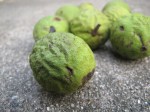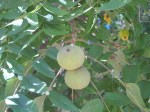Cocktails flavored with different plants and herbals are now all the rage among foodies and at popular restaurants. Beyond the garden, foraged, wild flavors can be gathered from the woods and fields to be blended into infused liqueurs, simple syrups and handmade bitters for the cocktail cart.
The windfall of falling walnuts becomes noticeable in mid-summer as the green fruits of the black walnut begin to drop. Your main competition for this fruit will be the local wildlife, particularly the ever-aggressive squirrel.
The wild walnut of the Juglans nigra (black walnut) is a forager’s delight – not only does it offer delicious nutmeats for cooking and baked goods, but the green hull has a fragrant, citrus-like aroma that infused in liquor makes a delicious aperatif.
Traditionally, nocino is made from the English walnut, but here in the Midwest, black walnut may be used. In some literature, there has been question whether or not the juglone content of the roots in the black walnut render the nut inedible (as it is a gardener’s nightmare for plants intolerant of the juglone), but there is enough traditional and contemporary use of the black walnut to negate this potential concern. The only issue that the black walnut may cause is in companion planting in the garden!
For more tips on identifying the black walnut, get a copy of my book, Midwest Foraging to take with you into the fields!
In “Midwest Foraging,” I describe that the green hulled walnut can be transformed into a traditional Italian digestif known as nocino, an aromatic spicy liqueur that contains clove, orange peel, nutmeg, and cinnamon. Try making a nocino with the herbs of the spicebush, tulip poplar, and wild ginger.”
To make your own nocino, gather 4 quarts of green walnut hulls. In the kitchen, stuff large ball jars to the brim with the nuts, including a tablespoon each of clove, juniper berries, orange peel, cardamon, ginger, and 2 cinnamon sticks. Cover completely with vodka (or white wine), and let macerate for 8 weeks. Strain and preserve in a glass bottle to let age.
Enjoy as a sipping liqueur or in a dessert course with fragrant cheese and dark chocolates.






black walnut hulls make a lovely dark brown dye…and it’s substantive,
I forage in VT. Now’s the time to make Indian Lemonade from the stag horn sumac…fiddleheads and ramps are gone. still a bit of wild ginger…lots of Jerusalem Artichokes.
no longer living by the ocean, i’m making do with dried Irish Sea Moss.
black trumpets and chanterelles abound and polyphores…no sign of the hen of the woods this year. And i took such good care of it.
I forage for plant and lichen dyes (i’m a spinner) and for basketry materials. Wish you were closer…i’d share whatever knowledge i have…been harvesting for over 60 years.
Looking forward to finding your book. Best, Barbara
Pingback: Episode 1545: Midwest Foraging with Lisa Rose | The Permaculture Podcast
I am just coming across this wonderful blog. I have just purchased your book. You and I are from the same neck of the woods!